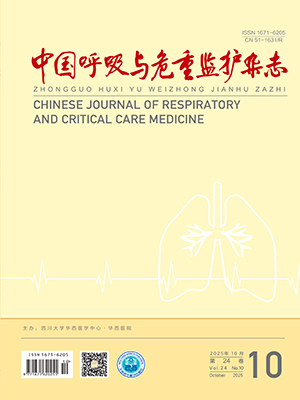| 1. |
洪建国, 王乃礼. 哮喘的吸入治疗和吸入装置. 临床儿科杂志, 2000, 18(3): 185-186.
|
| 2. |
Bateman ED, Hurd SS, Barnes PJ, et al. Global strategy for asthma management and prevention: GINA executive summary. Eur Respir J, 2008, 31(1): 143-178.
|
| 3. |
中华医学会儿科学分会呼吸学组. 儿童支气管哮喘防治常规(试行). 中华儿科杂志, 2004, 42(2): 100-106.
|
| 4. |
中华医学会儿科学分会呼吸学组. 儿童支气管哮喘诊断与防治指南(2016 年版). 中华儿科杂志, 2016, 54(3): 167-181.
|
| 5. |
苏远力, 郑劲平, 高怡. 我国医院使用雾化吸入治疗状况的问卷调查和分析. 中华结核和呼吸杂志, 2010, 33(2): 140-141.
|
| 6. |
孟海艳, 顾颖, 崔晓莉. ICU 雾化吸入技术应用现状调查及分析. 齐齐哈尔医学院学报, 2012, 33(21): 2991-2993.
|
| 7. |
洪建国. 进一步规范儿童雾化吸入治疗. 中国实用儿科杂志, 2016, 31(12): 881-883.
|
| 8. |
中华医学会呼吸病学分会《雾化吸入疗法在呼吸疾病中的应用专家共识》制定专家组. 雾化吸入疗法在呼吸疾病中的应用专家共识. 中华医学杂志, 2016, 96(34): 2696-2708.
|
| 9. |
Gardenhire DS, Ari A, Hess D, et al. A Guide to Aerosol Delivery Devices for Respiratory Therapists, 4th Edition. American Association for Respiratory Care, 2017.
|
| 10. |
洪建国, 陈强, 陈志敏, 等. 儿童常见呼吸道疾病雾化吸入治疗专家共识. 中国实用儿科杂志, 2012, 27(4): 265-269.
|
| 11. |
Martin AR, Finlay WH. Nebulizers for drug delivery to the lungs. Expert Opin Drug Deliv, 2015, 12(6): 889-900.
|
| 12. |
Pritchard JN. Nebulized drug delivery in respiratory medicine: what does the future hold?. Ther Deliv, 2017, 8(6): 391-399.
|
| 13. |
Arulmuthu ER, Williams DJ, Baldascini H, et al. Studies on aerosol delivery of plasmid DNA using a mesh nebulizer. Biotechnol Bioeng, 2007, 98(5): 939-955.
|
| 14. |
Griese M, Scheuch G. Delivery of alpha-1 antitrypsin to airways. Ann Am Thorac Soc, 2016, (13 Suppl 4): S346-S351.
|
| 15. |
Galindo-Filho VC, Ramos ME, Rattes CS, et al. Radioaerosol pulmonary deposition using mesh and jet nebulizers during noninvasive ventilation in healthy subjects. Respir Care, 2015, 60(9): 1238-1246.
|
| 16. |
ElHansy MHE, Boules ME, El Essawy AFM, et al. Inhaled salbutamol dose delivered by jet nebulizer, vibrating mesh nebulizer and metered dose inhaler with spacer during invasive mechanical ventilation. Pulm Pharmacol Ther, 2017, 45: 159-163.
|
| 17. |
Elhissi AM, Faizi M, Naji WF, et al. Physical stability and aerosol properties of liposomes delivered using an air-jet nebulizer and a novel micropump device with large mesh apertures. Int J Pharm, 2007, 334(1-2): 62-70.
|
| 18. |
赵德育. 不同雾化吸入装置特点及使用要点. 中国实用儿科杂志, 2016, 31(12): 895-898.
|
| 19. |
Nikander K, von Hollen D, Larhrib H. The size and behavior of the human upper airway during inhalation of aerosols. Expert Opin Drug Deliv, 2017, 14(5): 621-630.
|
| 20. |
Pilcer G, Amighi K. Formulation strategy and use of excipients in pulmonary drug delivery. Int J Pharm, 2010, 392(1-2): 1-19.
|
| 21. |
Jaafar-Maalej C, Andrieu V, Elaissari A, et al. Assessment methods of inhaled aerosols: technical aspects and applications. Expert Opin Drug Deliv, 2009, 6(9): 941-959.
|
| 22. |
Lipworth B, Manoharan A, Anderson W. Unlocking the quiet zone: the small airway asthma phenotype. Lancet Respir Med, 2014, 2(6): 497-506.
|
| 23. |
Tsuda A, Henry FS, Butler JP. Particle transport and deposition: basic physics of particle kinetics. Compr Physio, 2013, 3(4): 1437-1471.
|
| 24. |
中华医学会呼吸病学分会呼吸治疗学组. 雾化治疗专家共识(草案). 中华结核和呼吸杂志, 2014, 37(11): 805-808.
|
| 25. |
Demoly P, Hagedoorn P, de Boer AH, et al. The clinical relevance of dry powder inhaler performance for drug delivery. Respir Med, 2014, 108(8): 1195-1203.
|
| 26. |
Sheth P, Stein SW, Myrdal PB. The influence of initial atomized droplet size on residual particle size from pressurized metered dose inhalers. Int J Pharm, 2013, 455(1-2): 57-65.
|
| 27. |
Geller DE, Eigen H, Fiel SB, et al. Effect of smaller droplet size of dornase alfa on lung function in mild cystic fibrosis. Dornase Alfa Nebulizer Group. Pediatr Pulmonol, 1998, 25(2): 83-87.
|
| 28. |
Mallol J, Rattray S, Walker G, et al. Aerosol deposition in infants with cystic fibrosis. Pediatr Pulmonol, 1996, 21(5): 276-281.
|
| 29. |
Schüepp KG, Devadson S, Roller C, et al. A complementary combination of delivery device and drug formulation for inhalation therapy in preschool children. Swiss Med Wkly, 2004, 134(13-14): 198-200.
|
| 30. |
Köhler E, Jilg G, Avenarius S, et al. Lung deposition after inhalation with various nebulisers in preterm infants. Arch Dis Child Fetal Neonatal Ed, 2008, 93(4): F275-F279.
|
| 31. |
Janssens HM, De Jongste JC, Hop WC, et al. Extra-fine particles improve lung delivery of inhaled steroids in infants: a study in an upper airway model. Chest, 2003, 123(6): 2083-2088.
|
| 32. |
Myrdal PB, Sheth P, Stein SW. Advances in metered dose inhaler technology: formulation development. AAPS PharmSciTech, 2014, 15(2): 434-455.
|
| 33. |
朱俊, 陈保垒, 卢嘉彤, 等. 不同喷射雾化器对吸入混悬液体外沉积性质的影响. 国际药学研究杂志, 2016, 43(6): 1140-1144.
|
| 34. |
Carvalho TC, McConville JT. The function and performance of aqueous aerosol devices for inhalation therapy. J Pharm Pharmacol, 2016, 68(5): 556-578.
|
| 35. |
Hussein RRS, M A Ali A, Salem HF, et al. In vitro/in vivo correlation and modeling of emitted dose and lung deposition of inhaled salbutamol from metered dose inhalers with different types of spacers in noninvasively ventilated patients. Pharm Dev Technol, 2017, 22(7): 871-880.
|
| 36. |
Svartengren K, Lindestad PA, Svartengren M, et al. Deposition of inhaled particles in the mouth and throat of asthmatic subjects. Eur Respir J, 1994, 7(8): 1467-1473.
|
| 37. |
Svartengren K, Lindestad P, Svartengren M, et al. Added external resistance reduces oropharyngeal deposition and increases lung deposition of aerosol particles in asthmatics. Am J Respir Crit Care Med, 1995, 152(1): 32-37.
|
| 38. |
Nikander K, Prince I, Coughlin S, et al. Mode of breathing-tidal or slow and deep-through the I-neb Adaptive Aerosol Delivery (AAD) system affects lung deposition of 99mTc-DTPA. J Aerosol Med Pulm Drug Deliv, 2010, 23 Suppl 1: S37-S43.
|
| 39. |
van Velzen AJ, Uges JW, Le Brun PP, et al. The influence of breathing mode on tobramycin serum levels using the I-neb AAD system in adults with cystic fibrosis. J Cyst Fibros, 2015, 14(6): 748-754.
|
| 40. |
成人慢性气道疾病雾化吸入治疗专家组. 成人慢性气道疾病雾化吸入治疗专家共识. 中国呼吸与危重监护杂志, 2012, 11(2): 105-110.
|




